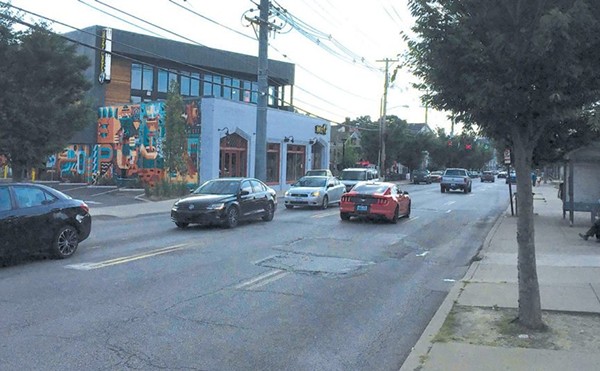CORRECTION
• Last week’s “Editor’s Note” referred to Ed McClanahan’s novel “The Natural Man” as, wrongly, “The Natural.” We regret the error.
• In last week’s cover story, we reported there are six members of The Brick House’s board of directors. There are eight. As well, the newspaper identified John Hicks as a newspaper columnist. He was publisher of the Fern Creek Neighbor from 1976-86.
STILL STANDING
Mat Herron’s story was a much needed reality check for us here at the Brick House, and we thank him for that (LEO Weekly, “Black Hole,” Sept. 10). But it fell short in three big areas.
First, although our building may be shabby, it has not “devolved” to this point from some pristine condition. When we bought it in 2002, it had been standing vacant for more than 10 years and was literally a filthy rats’ nest. It took a year of volunteer do-it-yourself (DIY) effort to get the building cleaned, repaired and up to code. Since then, a lack of funds has prevented further progress, but we are doggedly treading water, not drowning.
Second, we are not all resigned to business as usual. Several of us are actively pushing for longer-range planning. Your article would have done a great service had it presented the option some of us favor of selling the current building and buying another, more amenable one.
Our current location is a virtually windowless metal building facing north and occupying virtually every square inch of its 5,000-square-foot lot. But it is in the center of town with immediate access from I-65 and is zoned commercial (in a historic district where zoning is hard to come by).
Clearly the building would be more valuable to a commercial enterprise than to us. We would be more apt to thrive in a building with a little sunlight, a few more windows and some open space for gardens.
Third, you gave a full account of everything negative about the Brick House (most of which we acknowledge), but fell short in reporting the positive principles we stand for and the way we act on them. The Brick House is the only organization in town (and one of a handful in the country) dedicated to fostering individuality and self-reliance: encouraging individuals to take control of their lives and “do it themselves.”
Despite our limited facilities, week after week we still manage to apply our DIY approach in a broad spectrum of efforts: food (gardening and weekly pot lucks), transportation (our bike workshop), health (women’s health collective), education (“free school” classes), the media (our community radio station) and the arts (concerts, poetry, etc.).
As an aging baby boomer who has become maybe a little too jaded and cynical over the years, I find this DIY attitude in our younger generation to be heartening and invigorating. I consciously tried to convey this to Mat during a long telephone interview; I regret that only my jaded, cynical comments — made later, while giving him a tour of the building — were reported.
The article concludes by implying that we should hire a grant writer or development director, and I feel sure the board will soon be considering that. I would hope that, in the long run, an organization dedicated to individuality and self-reliance will be able to muster enough support from the general public that it need not be reliant on “the public trough.”
So I call on the people of Metro Louisville to rally to support this precious free space in our midst. Register as a member at brickhouse.cc. Join a DIY group or form one of your own. Volunteer to serve as a board member or grant writer. And please, demonstrate your support by chipping in a few bucks a month at SaveTheBrickHouse.org.
John Hicks, member of the board of directors of Brycc House Inc.
FOR HUMANITY’S SAKE
For years, I have been unnerved when a news report suggests after a horrendous crime, the perpetrator “has a history of mental illness.” As if to suggest this somehow explains the crime. As a psychiatrist charged with the assessment of dangerousness, I have recognized different types of potential violence. One is non-directed or paranoid, in which a patient who is actively hallucinating, delusional or delirious may rarely strike at the most proximate person unfortunate enough to invade their personal space. Another is a malicious disregard for fellow mankind that has nothing to do with illness. I have known very psychotic schizophrenics who would never harm a fly. I have met sociopaths with an alleged history of psychosis because they have learned that if they claim a voice told them to do it, they go to the hospital instead of jail.
The unintended consequence of eliminating the death penalty for the mentally ill is twofold. The first is the implication that the second, malicious sort of violence is the direct result of mental illness, which is undoubtedly false. The second is a perpetuation of the stigma of mental illness wherein healthy citizens are misled into believing that seeking psychiatric care is admitting that you are a dangerous, broken being. I support eliminating the death penalty, but only because of humanity. Any circumstance that we hold as a potential exemption bears the double-edged sword of denigrating the condition; rendering one subhuman. A normal person would be guilty, but this one …
Ben Schoenbachler, Louisville
CONDEMNING HISTORY
Regarding the “Crazy and Condemned” story (LEO Weekly, Sept. 3): It saddens me to think that there are actually individuals out there who are so concerned and hypersensitive that they are worried more about the welfare of one potentially unstable and allegedly “mentally ill” confessed killer than the welfare of the public at large.
If there is even a minute chance that someone has killed, regardless of “mitigating factors caused by mental illness,” why would we, as the public, not want the chance for them to repeat such a heinous crime? The death penalty in such cases is not barbaric, it’s insurance against the potential of history repeating.
Chris Kamerer, Floyds Knobs





